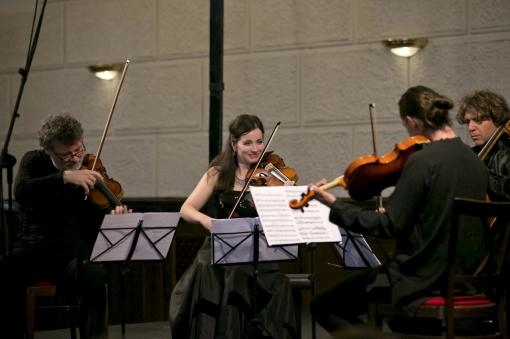After the first successful concert of the Concentus Moraviae festival’s resident ensemble at the castle in Slavkov, the ensemble led by violinist Pavel Fischer expanded to include pianist Katya Apekisheva and on Sunday, 12 June, in the Great Hall of Mikulov Castle, presented an unknown face of the musical language of Hungarian composer Béla Bartók with his Piano Quintet in C Major. Along with Fischer and Apekisheva, the concert also featured violinist Markéta Janoušková, violist Diede Verpoest, and cellist Erich Oskar Hütter.
The program opened with one of Bartók’s most popular works for solo piano – the approximately two and a half minute Allegro Barbaro. Katya Apekisheva did not dwell on the work too much and almost as soon as she sat down, she launched into succinct chordal confessions with clear and crisp accents. There was some excellent work with dynamics in softening the music and thinning out the rate (while expanding the rhythmic aspect) about halfway through the piece. Here the soloist worked particularly well with the strong accents and sudden dynamic peaks, resulting in a moving and musical performance.
After an energetic opening piece, the concert’s drama continued with movements from Molto adagio and Allegro from violinist and resident ensemble leader Pavel Fischer’s String Quartet No. 1 “Morava”. The Molto adagio brings out the dark tremolo of Erich Oskar Hütter’s cello, which is contrasted here with the calmly flowing middle voices of the second violin (Markéta Janoušková) and viola (Diede Verpoest), but above all with the harmonics of the first violin performed by the composer himself. Fischer’s tone was delicate, intonationally flawless, and above all completely stable without the slightest fluctuations that would have detracted from the musical effectiveness of the aforementioned harmonics. More and more driving fragments of melodic lines based on folk music emerge from the calmly stretching musical surface. The dynamic contrasts and the sudden short crescendos and decrescendos of the ensemble were also excellent. The Allegro that followed is already reminiscent of dulcimer music in an unmistakable way, not only in its melodicism but also in its characteristic form of embellishment and fast figurations. This does not mean, however, that the “artifice” aspect of the movement completely disappeared; I would say even the opposite – the symbiosis of classical and folk music techniques is extremely successful here, and the musical result is better and more interesting than the sum of the two parts all thanks to composer and violinist Pavel Fischer’s deep experience with these musical traditions. Moreover, the ensemble’s musical staging managed to bring out this inherent liveliness appropriately and, for example, the accents in Diedo Verpoest’s viola were “folkish” in the best sense of the word, giving the movement the motion it needed.
The centrepiece of the evening was Bartók’s Piano Quintet in C Major, in which soloist Katya Apekisheva and the string quartet joined forces, this time with Markéta Janoušková as first violin and Pavel Fischer as second violin. The Piano Quintet in C Major is not a work that the listener is likely to immediately associate with Bartók’s name – a sweeping late Romantic melodicism that would find many points of contact with the works of Johannes Brahms, Antonín Dvořák or, to a large extent, Richard Strauss, rather than with the modernists among whom we now attribute it. The opening Andante, however, already makes it clear that although this is not yet Bartók’s signature work, his precise motivic work and his sense of handling of meter and rhythm are already present. Although the movement titles – Andante is followed by Vivace (Scherzando), Adagio and Poco a poco più vivace – suggest a fairly clear tempo framework, Bartók changes tempo several times within the movements. In the performance by the Concentus Moraviae Festival Ensemble-in-Residence, these changes have been captured in a way that is as natural and appropriate to the musical flow as possible. At the same time, it should be emphasised that the whole ensemble maintained rhythmic homogeneity during these changes. The performers should also be commended for the variety of dynamic shades, especially in the final Poco a poco più vivace. Pianist Katya Apekisheva showed excellent understanding in her interpretation of the characteristically different parts of each movement, and the contrasts in her staging appropriately accentuated the sense of compositional variety in Bartók’s work. She also deserves enormous praise for her flawless handling of the not always ideal reversed notes, which the soloist herself had to reverse several times. It should be stressed that these were virtually always fast-paced musical passages, which in themselves are reason enough for a dizzying heartbeat – turning the pages of notes too soon in such a situation certainly does not make the performance any easier for anyone.
The second concert of the Concentus Moraviae festival’s resident ensemble followed on from the successful evening at the Slavkov castle and brought a not very often performed work by one of the most original composers of the 20th century. Although it was a largely eclectic composition, its musical qualities cannot be denied, and although Bartók himself wanted to destroy the Piano Quintet in C Major, it is good that it appears now and then on concert programs, for it shows us a young and gifted composer who is still searching for his musical language, the seeds of which, however, are already slowly but surely “being born beneath his hands”. And it is this perspective that, in my opinion, adds even more beauty to the artist’s work.
Katya Apekisheva / piano
Pavel Fischer / violin, artistic director
Markéta Janoušková / violin
Diede Verpoest / viola
Erich Oskar Hütter / cello
Program:
Béla Bartók: Allegro barbaro BB 63 (Sz. 49)
Pavel Fischer: Morava Quartet (2 movements)
Béla Bartók: Piano Quintet in C major BB 33 (Sz. 23)
Mikulov, Castle, Great Hall
19 June 2022, 19:30
































No comment added yet..